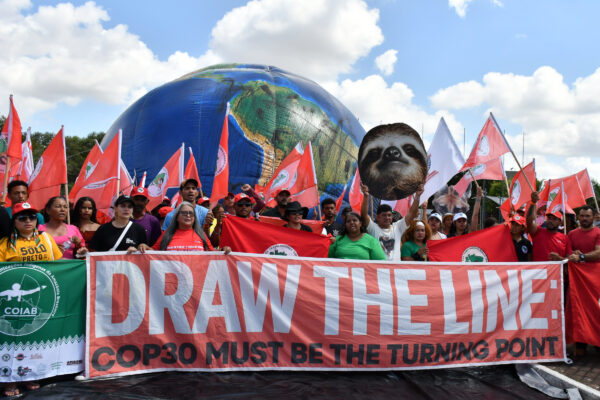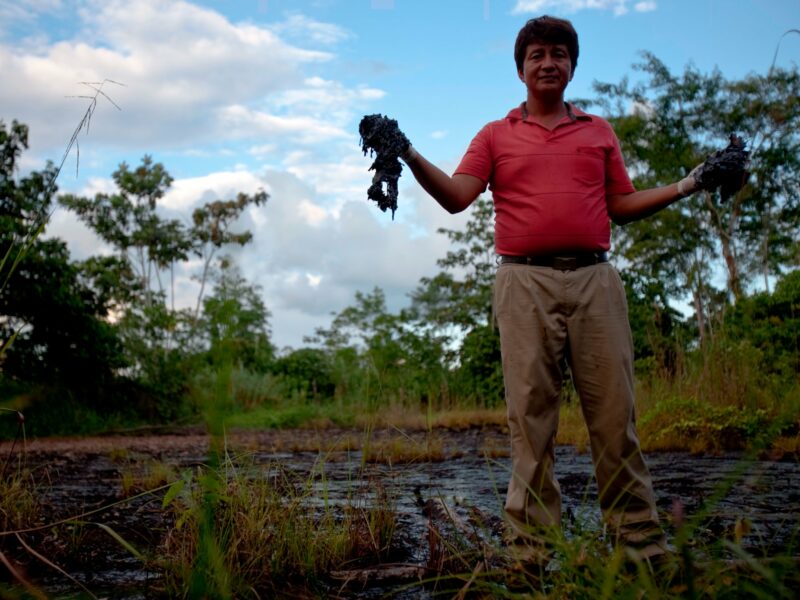Washington – Leaders of indigenous communities in Ecuador are pressing their government to investigate senior executives from U.S. oil giant Chevron for an alleged environmental fraud scheme in the mid-1990s related to a long-running six-billion dollar class action suit in the South American nation.
But the U.S. oil giant vehemently denies the accusations and says it has already been absolved by the local authorities.
Leaders from CONAIE, Ecuador’s powerful indigenous federation, which represents millions of people, say in a new letter to the Quito government that the U.S. company defrauded the authorities during an environmental clean-up more than nine years ago.
The indigenous leaders named Rodrigo Perez Pallares, Chevron’s legal representative in Ecuador, and Ricardo Reis Veiga, currently a Chevron vice president in charge of downstream operations in Miami, as the masterminds behind a plan that produced “false laboratory tests” to make the environmental damage look far less threatening.
The indigenous people’s letter claims that the officials’ work severely underestimated the amount of toxins in the soil, with the aim of guaranteeing a legal release from future government claims.
The alleged operation involved bulldozing soil and organic debris on top of waste pits rather than cleaning them of poisonous toxins in the 1990s. The letter asserts that both lawyers oversaw this shoddy remediation. Later, Chevron tried to use the action as a defence in various lawsuits arising out of the ecological disaster in Ecuador.
“The crux of the argument is that there was a deliberate effort on the part of Texaco at the time to misrepresent the evidence on the quality of the clean-up and to mislead the Ecuadorian government into thinking a proper remediation has been carried out,” said Kevin Koenig of Amazon Watch, a U.S. environmental organisation that is supporting the indigenous people.
The letter seeking the criminal investigation was signed by CONAIE president Luis Macas; Justino Piaguaje, leader of the Secoya indigenous community; Ivan Piaguaje of the Siuna indigenous group; Luis Narvaez of the Cofan indigenous group; and Eduardo Delgado, a former priest who is the president of Ecuador Decides, a civic group.
The tension between the U.S. oil company and the local communities in Ecuador dates back to the original lawsuit in Ecuador, which started in 2003.
The suit alleges that Texaco, now Chevron, dumped a whopping 18.5 billion gallons of toxic waste into Ecuador’s rainforest between 1964 and 1992, as it operated a concession that contained 350 well-sites.
The suit also claims Chevron left roughly 1,000 open air toxic waste pits in Ecuador’s ecologically sensitive Amazon rainforest.
Chevron’s media office didn’t return phone calls from IPS but in recent statements on its website, the company contends that it completed a 40 million dollar remediation programme in 1998, which led the government of Ecuador and its environmental agencies to unconditionally release the company from all liabilities and obligations related to the oil operations.
Local representatives and activists, however, say that damage is estimated at much more than the 40 million dollars Chevron spent.
“40 million dollars may seem like a lot of money but compared to the extent of the damage that was done, it’s minimal,” said Koenig.
When the U.S. firm Global Environmental Operations carried out an independent damage assessment, it estimated that the necessary clean-up costs would amount to at least 6.14 billion dollars.
And if personal damages are added in, the toll could rise up to well over 10 billion dollars, according to lawyers for the plaintiffs.
The company says that the Ecuadorian government and the Energy Ministry were not only well informed of exploration activities, but controlled the entire oil exploration operation in the Oriente region.
The oil giant counters accusations from environmentalists and indigenous organisations saying that during the primary period of production activity, the state oil company, PetroEcuador, had the majority interest and the majority of benefits from all operations, and therefore any claims should be made against the government and not against Chevron.
“The Republic of Ecuador has made clear that there is no evidence to support the claim of fraud,” Ricardo Veiga, Chevron vice president and general counsel, Latin America products said in a statement.
In the communiqué, the company said that with well over two years of legal proceedings in the Superior Court in Nueva Loja and completion of 45 of 122 judicial inspections of oil field sites, “the overwhelming body of evidence shows that the people of the Oriente region face no significant oil-related health risk from the areas remediated” by the company.
“This evidence clearly refutes the claims made by the plaintiffs’ lawyers,” the statement said.
But the letter by the indigenous groups says evidence is mounting to the contrary and would incriminate the company.
Of the 45 oil production sites inspected by court-appointed technical experts, many still show concentrations of carcinogenic chemicals at hundreds and sometimes thousands of times higher than U.S. acceptable standards.
The final phase of the trial, which will produce a damages claim, is expected to start within weeks and finish by this summer. A final decision could come in 2008. (END/2007)












